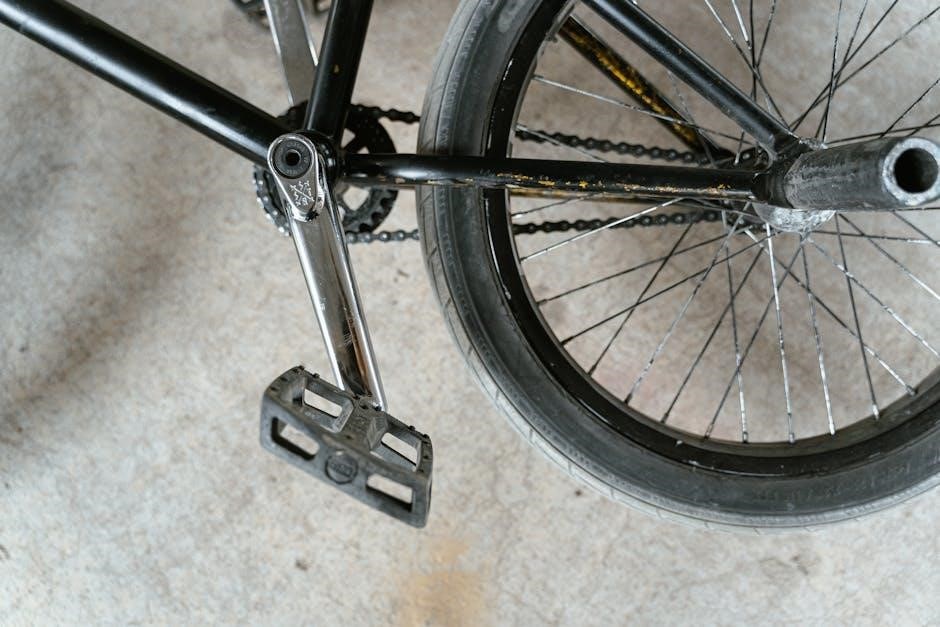
bike tire width guide
Understanding bike tire width is essential for optimizing stability, comfort, and performance. It influences ride quality, rolling resistance, and traction, ensuring proper fit for your bike and riding style.
Overview of Bike Tire Width Importance
Tire width significantly impacts a bike’s stability, comfort, and performance. Wider tires enhance grip and comfort, while narrower tires reduce rolling resistance for speed. Proper width ensures safety, efficient handling, and compatibility with terrain, rider weight, and bike type, making it a critical factor in optimizing your cycling experience.
Key Factors Influencing Tire Width Selection
Risks of Improper Tire Fit
Improper tire fit can lead to poor handling, reduced safety, and increased risk of accidents. Incorrect width may cause tire rub, damage to frames or rims, and decreased performance. Ensuring proper fit is crucial for optimal safety, efficiency, and rider confidence.

How Tire Width Affects Ride Quality
Tire width significantly impacts stability, comfort, and speed. Wider tires offer better traction and comfort but may increase rolling resistance, while narrower tires enhance efficiency but reduce stability.
Stability and Comfort
Wider tires enhance stability and comfort by increasing the contact patch with the road, reducing vibration, and improving shock absorption. Narrower tires, while faster, may compromise comfort and stability, especially on uneven surfaces.
Rolling Resistance and Speed
Tire width significantly impacts rolling resistance and speed. Narrower tires reduce rolling resistance, allowing for faster acceleration and higher speeds, making them ideal for road bikes. Wider tires, while offering stability, increase rolling resistance, which can slow the bike, especially on smooth surfaces.
Traction and Handling
Wider tires provide a larger contact patch, enhancing traction and grip, especially on loose or uneven surfaces. This improves handling and cornering confidence. Narrower tires, while faster, may compromise traction. The right width balances grip and efficiency, ensuring optimal performance for your specific riding conditions and terrain.

Understanding Tire Size Designations
Bike tire sizes are marked using ETRTO (ISO), inch-based, or French systems. These designations specify width, diameter, and compatibility, ensuring proper fit for rims and frames.
ETRTO System (ISO Measurements)
The ETRTO system, or ISO measurements, provides precise tire and rim compatibility. It specifies width and diameter in millimeters, ensuring accurate fit. For example, 37-622 indicates a 37mm width and 622mm diameter, guaranteeing safety and performance by matching tires to rims correctly.

Inch-Based System
French Designation System
The French system uses a combination of letters and numbers, such as “700x25c,” where “700” indicates diameter and “25” denotes width. The “c” refers to the tire’s intended use. Though less common today, it remains relevant for certain bike types, providing essential compatibility information for manufacturers and cyclists alike.
The French system denotes tire size with a combination like “700x25c,” where “700” is the diameter, “25” is the width, and “c” indicates the tire type. This system is less common today but still used for specific bike types, ensuring compatibility and providing clear sizing information for manufacturers and cyclists.
Importance of Proper Tire Fit
Proper tire fit ensures safety, optimal performance, and comfort by preventing damage and maintaining recommended clearances, as specified by manufacturers for each bike model.
Why Proper Tire Width Matters
Proper tire width ensures optimal stability, comfort, and performance by matching your riding style and terrain. It prevents excessive wear, improves safety, and maintains compatibility with rims, enhancing overall ride quality and efficiency.
Improper tire fit can lead to poor handling, reduced safety, and increased risk of tire failure. It may also cause damage to the bike frame or rims, compromising ride performance and potentially leading to accidents. Always adhere to manufacturer guidelines for optimal performance and safety.

Measuring Tire Width
To accurately measure tire width, ensure the tire is inflated. Locate the widest point, typically where the tire contacts the ground. Use a ruler or caliper to measure across this point, perpendicular to the rim, ensuring accuracy and consistency. This method applies to various tire types and ensures proper fit for optimal performance and safety.
How to Accurately Measure Tire Width
To measure tire width accurately, inflate the tire to its recommended pressure. Locate the widest point, typically where the tire meets the ground. Use a caliper or ruler to measure across this point, ensuring the tool is perpendicular to the rim. Record the measurement in millimeters for precise sizing and compatibility checks.
Matching Tire Width to Rim Width
Matching tire width to rim width ensures optimal performance and safety. Measure the rim’s inner width using a caliper, then compare it with the tire’s width. Use manufacturer guidelines or compatibility charts to find the ideal combination, ensuring at least 6mm clearance on both sides for proper fit and functionality.

Factors to Consider When Choosing Tire Width
Factors include riding style, terrain, bike type, rider weight, and load. Wider tires suit rough terrain and heavier loads, while narrower tires optimize speed on smooth surfaces.
Riding Style and Terrain
Riding style and terrain significantly impact tire width choice. Wider tires (2.0″+) suit rough, uneven surfaces like trails, offering better grip and control. Narrower tires (23-28mm) excel on smooth roads, enhancing speed and efficiency. Gravel and mixed terrain often require mid-width tires (30-42mm) for balance between comfort and performance.
Bike Type and Discipline
Different bike types require specific tire widths. Road bikes use narrower tires (23-32mm) for speed and efficiency. Mountain bikes utilize wider tires (2.0″+) for traction on rough terrain. Gravel and cyclocross bikes often use mid-width tires (35-50mm) for versatility, balancing speed and stability across mixed surfaces.
Rider Weight and Load
Rider weight and load significantly impact tire width choice. Heavier riders or those carrying cargo benefit from wider tires for added stability and support. Proper tire pressure adjustment is crucial to maintain performance and safety, ensuring the tire can handle the weight without compromising comfort or handling. Manufacturer guidelines often provide specific recommendations.
Different Cycling Disciplines and Tire Widths
Various cycling disciplines require specific tire widths for optimal performance. Road bikes favor narrower tires for speed, while mountain bikes use wider tires for traction. Gravel bikes strike a balance, offering versatility across mixed terrain. Each discipline’s tire width is tailored to enhance ride quality, stability, and handling in its specific environment.
Road Bikes
Road bikes typically use narrower tires, ranging from 23mm to 32mm, prioritizing speed and efficiency. Wider tires, like 28mm or 32mm, offer improved comfort and traction without significantly compromising speed, making them popular for endurance and versatility on various road surfaces.
Mountain Bikes
Mountain bike tires typically range from 2.3 to 2.5 inches in width, offering enhanced grip and control on rough terrain. Wider tires provide better stability and traction, while narrower options improve agility. The chosen width depends on the specific trail conditions and the rider’s preference for speed versus maneuverability.
Gravel and Cyclocross Bikes
Gravel and cyclocross bikes often use tires between 35-50mm in width, balancing speed on pavement and traction on mixed terrain. Wider tires enhance control on loose surfaces, while narrower options maintain efficiency. The ideal width depends on the rider’s preference, terrain type, and the bike’s clearance capabilities.
Safety Considerations
Proper tire clearance and frame fit are critical to avoid safety risks. Improper fit can cause damage or accidents. Always follow manufacturer guidelines for safe tire width and pressure.
Clearance and Frame Fit
Ensuring proper tire clearance is vital for safety and performance. Measure frame and fork clearance accurately to avoid rubbing or obstruction. Always adhere to manufacturer-recommended maximum tire widths and maintain at least 6mm clearance around the tire for optimal fit and safety.
Recommended Tire Pressure
Proper tire pressure enhances ride quality and safety. Pressure varies by tire width, riding style, and weight. Road tires typically require 80-110 PSI, mountain bikes 25-40 PSI, and gravel bikes 40-60 PSI. Always check manufacturer guidelines for specific recommendations to ensure optimal performance and safety.

How to Choose the Right Tire Width
Consider riding style, terrain, and bike type. Check manufacturer guidelines for width range. Measure rim and frame clearance to ensure proper fit and performance.
Tire Width for Specific Riding Conditions
Narrow tires (23-28mm) suit road racing for speed and efficiency. Wider tires (30-40mm) are ideal for gravel and endurance rides, offering comfort and traction. Mountain bikes use 2.0″+ tires for rough terrain, while commuter bikes often opt for 32-42mm tires for versatility and durability in mixed urban environments.
Properly matching tire width to rim width ensures optimal performance and safety. Wider tires on wider rims improve stability and traction, while narrower tires on narrower rims reduce rolling resistance. Always consult compatibility charts to avoid damage and ensure proper fit, as mismatched widths can compromise ride quality and safety.

Tire and Rim Compatibility
Tire and rim compatibility is crucial for safety and performance. Ensure the tire width matches the rim width, adhering to ETRTO standards and manufacturer guidelines for optimal fit.
Understanding Rim Width and Tire Compatibility
Rim width significantly impacts tire compatibility. Wider rims allow tires to bulge for better traction, while narrower rims restrict width. Always adhere to ETRTO standards and manufacturer guidelines for optimal fit, especially for hookless or straight-side rims, to ensure safety and performance.
Using Compatibility Charts
Compatibility charts are essential tools for matching tire widths to rim widths. They provide clear guidelines to ensure optimal performance and safety. By referencing charts like the WTB Tire & Rim Compatibility Chart, cyclists can avoid improper fit, which may damage rims or compromise ride quality. Always consult these guides for accurate sizing.

Measuring Rim and Frame Clearance
Accurate clearance measurement ensures proper tire fit and safety. Use calipers to measure rim width and frame tight spots, ensuring at least 6mm clearance around the tire for optimal performance.
How to Measure Frame Clearance
To measure frame clearance, use calipers to check the tightest spots where the tire meets the frame. Ensure there’s at least 6mm of space on all sides for safe operation and optimal performance. This step is crucial to avoid damage and ensure proper tire fit.
How to Measure Rim Width
To measure rim width, use a ruler or calipers to find the inner width of the rim at its widest point. Ensure accuracy by measuring across the inner edges. This dimension helps determine the optimal tire width for compatibility and performance, ensuring a safe and efficient ride.

Manufacturer Recommendations
Manufacturer guidelines are crucial for safety and performance. They specify maximum tire width and optimal compatibility, ensuring proper fit and ride quality for your specific bike type.
Understanding Manufacturer Guidelines
Manufacturer guidelines provide crucial information for safe and optimal tire performance. They specify maximum tire width, compatibility, and pressure recommendations, ensuring proper fit and ride quality. These guidelines are typically found in the bike’s manual or online, outlining the 6mm clearance standard and risks of non-compliance, such as frame damage or safety hazards.
Why Manufacturer Specs Matter
Manufacturer specifications ensure safety and optimal performance by detailing compatible tire widths and pressures. They prevent frame damage and safety hazards, ensuring proper fit and ride quality. Adhering to these guidelines is crucial for compatibility and to avoid risks associated with incorrect tire fitment, such as reduced stability or potential mechanical failure.
Selecting the right bike tire width enhances performance, safety, and comfort. Consider factors like riding style, terrain, and compatibility to make an informed decision for optimal cycling.
Summarizing Key Points
Bike tire width impacts stability, speed, and handling. Proper fit ensures safety and performance. Consider riding style, terrain, and manufacturer guidelines. Measure clearance and match tire width to rim for optimal compatibility. Wider tires offer comfort, while narrower ones enhance speed. Always prioritize correct sizing for an efficient and enjoyable ride.
Final Tips for Choosing the Right Tire Width
Always consult manufacturer guidelines for recommended widths. Measure frame and rim clearance accurately. Test different widths if possible. Prioritize tire durability for heavy loads. Consider terrain and riding style for optimal performance. Ensure proper tire pressure for safety and efficiency. Balance comfort and speed based on your specific cycling needs.